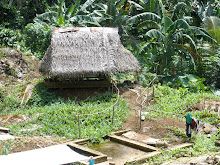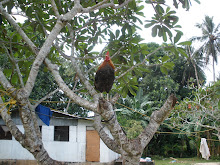Since posting the pictures of Kevin and Japanese WWII remains he has been exploring on Tonoas, I found the following information I thought might be of interest.
Tonoas, the traditional name for the island called Dublon during the war, was the location for the Japanese military and civil administration of Chuuk before, and during World War II. Tonoas was extensively modified leading up to, and during the war. Land was reclaimed, trees and vegetation were cleared, and traditional historic sites were interfered with. The massive migration of Japanese onto Tonoas had a big effect on the Chuukese living there. Before the war, under military (Navy) administration from 1914 to 1922, then civilian administration from 1922 to about 1937, Japanese and Chuukese lived reasonably comfortable together. The Japanese provided Chuukese with work, education and health, and as in other colonial settings, alienation of Chuukese land, and the breakdown of Chuukese traditional lifestyles commenced. The war changed this delicate relationship, many Chuukese were forced from their homes, and the island itself; education stopped; forced labour was introduced to carry-out the many military construction projects; and the breadfruit, coconut and banana trees were either cut-down or made unavailable for Chuukese consumption.
During the war Tonoas was a hive of activity. A civilian township comprising all the facilities to expect of a small town, called Dublon Town was located in the southeast section of the island. The Japanese Fourth Fleet was based on Tonoas and they established buildings and facilities, many of them were prefabricated wooden structures, built onto concrete foundations with a tin roof. There was also a submarine base, a seaplane base, a number of very large fuel tanks, and a repair facility for vessels. There was also a number of small and large buildings established as 'comfort houses' where women were forced to entertain Japanese men. The island contains numerous guns that were used in its defence, as well as many small and large tunnels to shelter people, equipment and munitions from the bombing.
Subscribe to:
Post Comments (Atom)







.jpg)
.jpg)









No comments:
Post a Comment